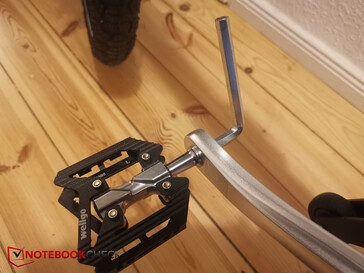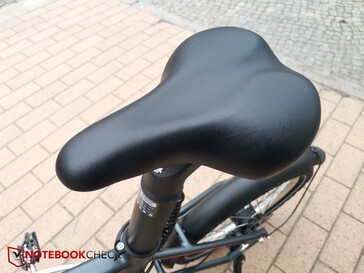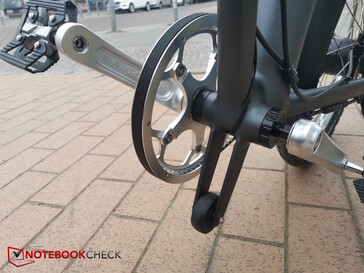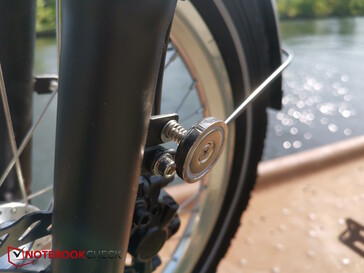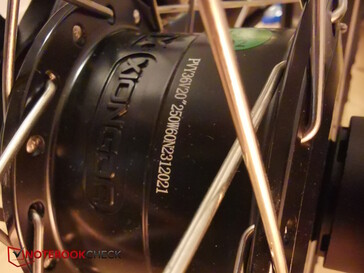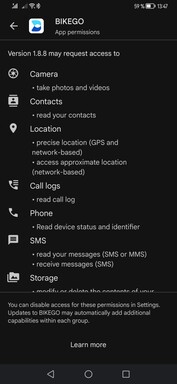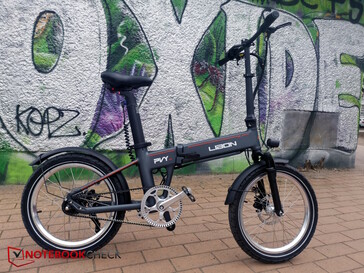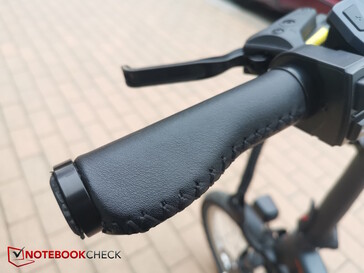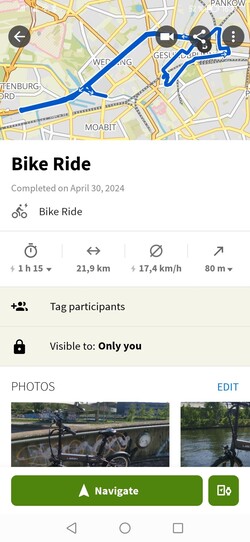PVY Libon folding e-bike hands-on review: King of range with dual battery?
We previously reviewed the Z20 Plus and Z20 Pro from PVY. Touted as the “longest range light folding e-bike”, the PVY Libon is a new belt-driven foldable launched by the company through a recently concluded Indiegogo campaign. The Libon is claimed to have a range of 260 km when fitted with a dual-battery system. However, this configuration is optional, and we’ve unfortunately received only the single-battery version for review. There is a price difference of roughly €200 (US$215) between the two variants, with dual-battery model priced at €1,499 vs and the single-battery at €1,299 on PVY’s website. That said, having a range of 130 km still sounds hugely impressive on paper. We’ve tested out the Libon folding e-bike to see how long it lasts in everyday use and what are its strengths and weaknesses.
Additionally, we will be comparing the Libon with the Ado Air 20, another folding e-bike that left a great impression as an urban commuter in our previous review.
Notes about legal situation
In response to our enquiries, PVY has repeatedly stressed that the bike is also legal to ride in Germany. Yet, several features suggest otherwise, including many of the options found in the on-board display. Options such as cruise control and the like aren’t allowed in Germany to our knowledge. Furthermore, the loud built-in horn may pose a problem for a bike. The ability to alter voltage and other parameters may also raise concerns. It is unclear whether the mere existence of such settings is problematic.
Past allegations have surfaced about the company use of fake certificates in advertising. Replying to our queries, PVY has assured us that the new EN 15194 certificate is currently being verified, a process that will require some time. Despite this, the maintains that the Libon is legal in Germany. However, this certificate is necessary for the CE marking, which must be present on every legal power-assisted bicycle in the country.
Given these uncertainties, we advise all potential buyers to thoroughly examine the regulations before purchasing the e-bike.
Assembly: saddle, handlebars, pedals, done
The Libon is shipped in a folded state within a large cardboard box. Various polystyrene parts protect the bike from damage during transport. Using cardboard would’ve been a more eco-friendly option.
Assembling the e-bike is easy: there isn't much else to do other than attaching the pedals and inserting the handlebars and seatpost. Whilst slightly more comfortable than the one on the Ado Air, the saddle unfortunately can’t be titled horizontally. We would’ve liked to raise the saddle’s tip ever so slightly.
Specifications and appearance: Hefty aluminium frame, drive belt and suspension fork
| Specs | PVY Libon |
|---|---|
| Motor | 250 W (500 W "unlocked") |
| Sensor | Torque sensor |
| Torque | 50 Nm |
| Max speed | 25 km/h (up to 32 km/h "unlocked") |
| Battery | Single: 36 V, 10 Ah; Dual: 36 V 10 Ah + 10.4 Ah |
| Charge time | Single: 2.5 h; Dual: 5 h |
| Drive system | Belt |
| Brakes | Hydraulic disc brakes |
| Weight | Single: 16 kg (35.2 lb); Dual: 18.5 kg (40.8 lb) |
| Tyres | 20 inch * 2.5 pneumatic tyres |
| Miscellaneous | Steel suspension fork, kickstand, aluminium pedals, 6 km/h walk assist mode |
| Security | Battery lock and GPS Tag |
| Price | Standard: €1,299 (US$1,400); Dual: €1,499 (US$1,615) |
In terms of colours, you have a choice between grey (as with our review unit) and white. The aluminium frame is very thick yet hollow, providing enough space to accommodate a second battery in the dual-battery version.
The Libon folding bike definitely strongly resembles the Z20 Plus and Ado Air. Compared with the latter, however, the Libon has a few differences that make it feel more sophisticated in certain details. Both bikes feature a low-maintenance belt drive rather than a chain drive.
But only the Libon has a front suspension fork, presumably designed to mitigate slight road imperfections, judging by its short suspension travel and very high stiffness. A convenient design choice is the Libon’s rear light, which is directly powered by the main battery, eliminating the need for a separate battery as seen on the Ado Air.
Before you fold the bike, the hinge must be opened. Once the hinge lock is released, you’ll need to apply quite a lot of force to open the large stiff hinge in the middle. Magnets on the front and rear wheel keep both halves of the frame together when the bike is folded.
You’ll also notice a tiny wheel designed to enhance the bike's stability and helps you roll the bike more comfortably in a folded state. Though this is a nice idea, it only works well on smooth surfaces. The small plastic wheel may struggle on road surfaces that are less smooth. The bike has a walk assist mode, allowint you to push the bike at speeds of up to 6 km/h with the help of the motor.
Brakes, suspension fork and tyres
The PVY Libon comes equipped with hydraulic disc brakes which are decently adjusted right out of the box, albeit not perfectly. On our review unit, the front brake, in particular, emits a loud and unpleasant squeak in wet conditions. However, we don’t have any complaints about the braking performance.
As previously mentioned, the suspension fork is extremely stiff and has limited travel. We can't say for certain whether it really adds anything to the product, especially since the slightly wider and thicker tyres already provide some cushioning. We hardly noticed any difference when comparing the Libon with the Ado Air, which lacks suspension.
Battery: Single- or dual-battery version
Things get interesting when you look at the seatpost. Similar to the Ado Air, one of the batteries is built into the chunky seatpost. However, there is no way to secure the 10-Ah battery on the Ado, requiring you to remove the heavy battery from the quick-release clamp and lug it around, along with the saddle, when parking the bike. PVY has done a much better job here: the seat clamp is fitted with a lock to prevent unauthorised removal of the battery seatpost. There is even a GPS tag included for enhanced theft protection.
The optional second battery, rated at 10.4 Ah, goes into the wide frame, but its removal is probably a little more complicated since you have to fold up the bike beforehand.
Needless to say, the dual-battery version is also slightly heavier, tipping the scales at 18.5 kg (40.8 lb). By contrast, our single-battery review unit weighs about 16 kg (35.3 lb), making it almost as light as the Ado Air, which doesn't feature suspension.
Motor: Xiongda rated at 250 W, or is it 500 W?
The rear hub motor, produced by Xiongda, has a rated power of 250 watts, which complies with regulations in Germany. However, PVY claims that the motor can reach 500 watts when “unlocked”, allowing the bike to achieve speeds of up to 32 km/h (roughly 20 mph). The 500-watt peak power shouldn’t be an issue, but the ability to ride at up to 32 km/h is definitely not legal in Germany. Therefore, it is appropriate to emphasise what we’ve previously mentioned about the legal situation: it's advisable not to “unlock” the motor.
The power-assist feature is regulated by a torque sensor, with the motor delivering a maximum torque of around 50 Nm.
Unlike the Z20 Plus, the PVY Libon lacks a gear system, effectively making it a single-speed e-bike à la the Ado Air 20.
Display and app: Standard display with many settings
The 2.4-inch IPS display is a fairly standard model that we’ve already seen on various e-bikes, including the Ado Air. The presentation isn’t particularly appealing, but the screen is easily readable. It shows you the current speed, assist mode (with options ranging from three to five modes), battery level, distance travelled and a few other parameters.
Holding the + and - keys simultaneously for a few seconds will open up the extensive option menu, which lets you adjust a myriad of options, including speed, assist mode, cruise control, e-brake, voltage, password protection and more. However, a few of these options may not comply with German regulations.
The display is capable of showing a QR code for pairing the bike with a smartphone and the BIKEGO app via Bluetooth. Naturally, the app will request a whole bunch of potential permissions.
You need to create an account within the app to access an expanded set of features. Only then can you unlock additional functions, such as the navigation feature on the bike’s display, which costs extra. The app doesn’t significantly enhance the user experience apart from this.
Real-life test ride: Comfortable city bike
We hopped on the bike and embark on a journey through Berlin, travelling from Seestraße (near S Bornholmer Straße) to a motorway and then taking detours and loops on the way back. Initially, the route consisted largely of long stretches of flat roads. This changed at around the turning point, marked by a spiral ramp leading to a pedestrian bridge over the A100 autobahn. There were a few minor inclines after that, but the paths were mostly flat.
Whilst our average speed was 20 km/h (12 mph) on our way to the turning point, it dropped on the more winding return leg. This is especially due to the fact that the amount of assist power decreases when battery level falls below 20%.
Ride experience
We noticed right away that the motor doesn’t propel you forward as energetically as the one on the Ado Air 20 regardless of the assist level. Because of this, as well as its chunkier frame and fork, the Libon feels heavier and less nimble than the Ado Air 20, despite having a similar weight. The riding experience is also not as fun and sporty as on the Air, but the battery will probably last longer in return (see below). The handlebars also feel slightly heavier by comparison.
Nevertheless, you can get moving just fine. Certain performance parameters can also be tuned in the settings, then again, surely at the expense of range (and possibly legality). The saddle is more comfy than on the Air. We would’ve preferred tilting the saddle’s tip very slightly upwards, but this is unfortunately not possible. The grips feature ergonomic palm rests.
The motor is quiet, though not as quiet as the one on the Air. You can sometimes still hear it “chugging” along softly in urban traffic.
The height of the seatpost and handlebars can be adjusted to suit the rider’s height and preference. The thick tyres provide pretty good cushioning. We can’t say for sure how much the front suspension fork contributes to ride comfort. Overall, the Libon seems like a comfortable single-speed city bike for everyday use. Thanks to the torque sensor, the assist kicks in quite quickly when you start pedalling.
We find it rather awkward that there is cable clutter right in the triangular section of the frame. This is where you might want to hold when lifting the bike, as the centre of gravity is located here. When lifting the bike, not only do the cables apply an uncomfortable pressure on your hand, but there is also concern about potentially damaging the electronics. It is difficult to carry the PVY Libon by other points on the frame.
Range
PVY claims our single-battery variant has an impressive range of 130 km (80 mi), and the dual-battery model is supposedly able to go twice as far – a whopping 260 km (160 mi)! Unfortunately, as is often the case in the industry, the provided figures are far from reality because the measurement conditions greatly differ from real-life situations. This is roughly how the Libon’s range was measured: on a straight, flat path at 15 km/h (9.3 mph) in Eco mode.
For our range test, we (weighing approx. 70 kg, or 154 lb) used the middle of the three assist levels. The battery was at 50% at the start of our test trip. The battery level dropped to 8% after around 22 km (13.7 mi) of travelling on a moderately varied route at an average speed of about 17.3 km/h (10.7 mph).
Once the battery level falls below 20%, the battery indicator will turn red and the amount of assist will reduce slightly but noticeably. The power throttling and reduced speeds allow the battery to last quite long subsequently and its level to drop more gradually.
Overall, battery level fell by approx. 42% during our 22 km trip (13.7 mi). Extrapolating this information suggests that the PVY Libon realistically has a range closer to 50 to 60 km (31 to 37 mi) in day-to day use and in our test scenario (approx. 70 kg load, assist level 2, few climbs, mostly flat route, and average speed of approx. 17.3 km/h). Of course, this doesn’t look as good as 130 km on the specs sheet, but is still a decent figure that, despite not setting any record, is better than what the Ado Air offers.
You can certainly get more range out of the battery if you switch to the lowest assist mode and ride at an average speed of 15 km/h (9.3 mph).
Pros
Cons
Verdict: Good e-city bike with belt drive
The PVY Libon feels more well-engineered and polished in some areas than, for example, the Ado Air. We particularly appreciate the battery lock, a feature sorely missed on the Air. It protects the battery against theft, eliminating the need to constantly to lug the battery around. The magnets help to keep the bike securely folded. The back light is powered by the built-in battery, unlike on the Air, which relies on a separate one. The belt drive is another feature we like.
The ride feel is noticeably less lively compared with its rival, the Air 20, making the Libon seem heavier and less nimble by comparison. Consequently, the Libon is not as fun to ride in a city as the Air. On the flip side, all of this contributes to the bike’s range, although the figures provided by the manufacturer are once again far from realistic. Then again, there is also the dual-battery variant, which should offer a range of 100 to 120 km (62 to 75 mi) if ridden similarly to our test.
Despite not being exceptionally speedy, the PVY Libon boasts a slightly longer range than usual and is particularly well-suited for city use thanks to its folding mechanism.
Price and availability
After the conclusion of its Indiegogo campaign, the PVY Libon is currently in production and has been shipping to customers since April. The single- and dual-battery models cost €1,299 (US$1,400) and €1,499 (US$1,615) respectively on PVY's website.
Transparency
The present review sample was made available to the author as a loan by the manufacturer or a shop for the purposes of review. The lender had no influence on this review, nor did the manufacturer receive a copy of this review before publication. There was no obligation to publish this review.


 Deutsch
Deutsch English
English Español
Español Français
Français Italiano
Italiano Nederlands
Nederlands Polski
Polski Português
Português Русский
Русский Türkçe
Türkçe Svenska
Svenska Chinese
Chinese Magyar
Magyar

